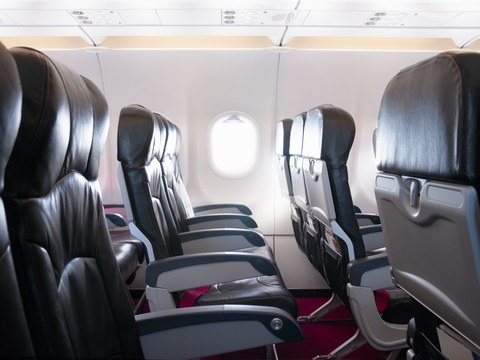It may be best to leave that seatback tray table in its upright and locked position, especially during the Thanksgiving travel rush.
Disease-causing bacteria on airplane surfaces can linger for days, even up to a week, research shows.
More than 55 million people are expected to travel this week, according to the American Automobile Association, the second-highest Thanksgiving holiday travel volume since it began tracking the numbers almost 20 years ago.
About 4.5 million Americans will fly, turning crowded airports and planes into hotbeds of germs during the cold and flu season.
A team of microbiologists and engineers at Auburn University in Alabama found that nasty bugs like antibiotic-resistant bacteria and viruses can hitch extended rides on armrests, window shades, tray tables, toilet handles and more.
“Many travelers are concerned about the risks of catching a disease from other passengers when they spend long hours in crowded air cabins,” Kiril Vaglenov, a post-doctoral fellow in materials science who led the study, told NBC News.
But, given the right circumstances, the study showed contact with objects is also risky and can lead to infection with methicillin-resistant Staphylococcus aureus, MRSA, or the E. coli O157:H7 gut bug that can cause kidney failure, Vaglenov said.
He presented some of the findings in 2014 at the annual meeting of the American Society for Microbiology.
He didn’t test the germs inside an operational plane. Instead, he collected old airplane parts from Delta Airlines, which partially funded the study along with the Federal Aviation Administration, and used them in his experiments.
The team applied MRSA and E. coli bacteria suspended in various solutions that mimicked human saliva and sweat.
What he found was unsettling for anyone who’s wondered how many fingers have touched the seat pocket that holds the in-flight instructions.
MRSA lasted 168 hours — a week — on a cloth seatback pocket, Vaglenov found. Other tests showed that E. coli O157 hung around for 96 hours — four days — on the material from the airplane armrest.
“I wouldn’t touch that pocket,” Vaglenov said. “I think that it should be replaced with something less porous.”
Delta officials emphasized that all surfaces in their planes are disinfected every night and before every departure, according to spokeswoman Lindsay McDuff.
But a top infection control specialist said it’s no surprise the Auburn team found bacteria survive so long on these surfaces.
“We live in a microbial environment or, we could say, in a germy world,” said Dr. William Schaffner, a professor of preventive medicine at Vanderbilt University in Nashville, Tennessee.
He called the study “overly meticulous” and suggested that the biggest worry on a plane isn’t the germs on the armrest, but the cold and flu viruses many passengers pack with their carry-ons.
How to avoid germs that cause illness:
Be mindful of the germ-infested spots: The headrest and seatback tray table are some of the most affected parts of an airplane.
Flight attendants have seen people change a baby’s diaper on the tray table. Other dirty spots include the seat belt, toilet flush button and air vent.
Be wary at the airport, too: a TODAY investigation found the presence of E. Coli, klebsiella and Acinetobacter in the plastic bins in the TSA security line.
“They’re all bacteria that we find normally in our intestines, so we call them fecal bacteria,” Dr. Susan Whittier of Columbia University Medical Center said. “It just means that those surfaces are contaminated with poop.”
Keep hand sanitizer gel or anti-bacterial wipes in your pocket and use them during your journey.
Ultimately, the best defense isn’t an arsenal of bleach wipes, but simple hand hygiene, Schaffner said: “It’s another reminder to wash our hands.”
Do it routinely throughout the day, but especially before you eat. Don’t put your unwashed hands in your mouth or rub your eyes.
Respect others: Don’t fly if you are sick.






